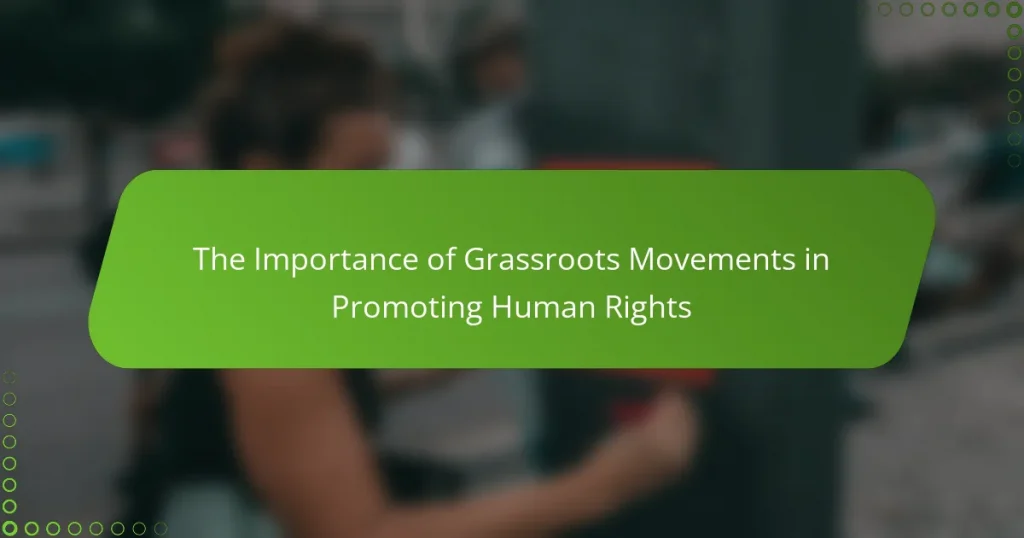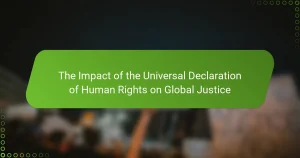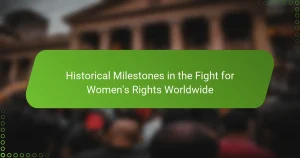Grassroots movements are community-led initiatives that focus on instigating social change, particularly for marginalized groups. These movements empower individuals to advocate for their rights and influence policy decisions, playing a vital role in promoting human rights through awareness and public mobilization. Key strategies employed by grassroots movements include community organizing, social media engagement, public demonstrations, and collaboration with non-governmental organizations (NGOs). Historical examples, such as the Civil Rights Movement in the United States and the anti-apartheid movement in South Africa, illustrate their effectiveness in challenging systemic injustices. Individuals can support these movements by volunteering, donating, raising awareness, and participating in events that foster community understanding and solidarity for human rights.
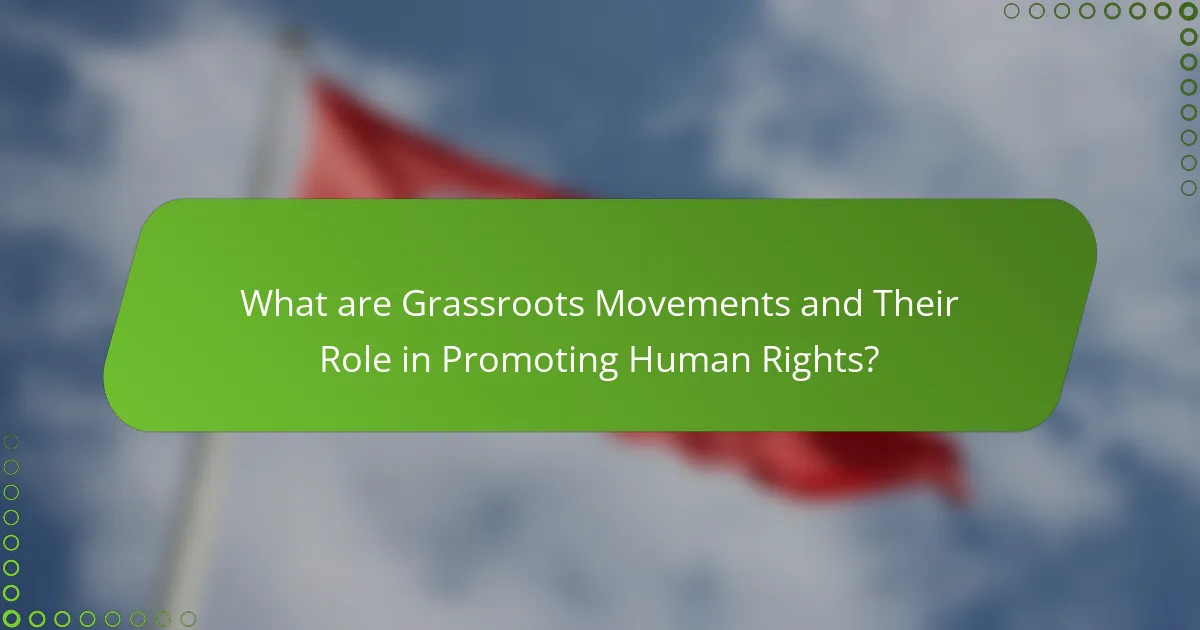
What are Grassroots Movements and Their Role in Promoting Human Rights?
Grassroots movements are community-led initiatives aimed at instigating social change. They often arise from local concerns and seek to address issues affecting marginalized groups. These movements empower individuals to advocate for their rights and influence policy decisions. They play a critical role in promoting human rights by raising awareness and mobilizing public support. Historical examples include the Civil Rights Movement in the United States and the anti-apartheid movement in South Africa. Both movements successfully challenged systemic injustices and led to significant legal reforms. Grassroots movements often utilize social media to amplify their messages and reach wider audiences. Their decentralized nature allows for diverse voices and perspectives to be heard.
How do Grassroots Movements differ from Traditional Activism?
Grassroots movements differ from traditional activism in their approach and structure. Grassroots movements are typically community-driven and focus on local issues. They often arise spontaneously from within the community, relying on the participation of ordinary citizens. Traditional activism, on the other hand, is often organized by established organizations or leaders. It may involve larger, more formal campaigns with structured hierarchies.
Grassroots movements emphasize direct action and local engagement. They often use social media to mobilize support quickly. Traditional activism may rely more on formal channels, such as lobbying and public relations. Grassroots efforts can adapt rapidly to changing circumstances. Traditional activism tends to follow a more planned and strategic approach.
Research shows that grassroots movements can lead to significant social change. For instance, the Civil Rights Movement in the United States was largely grassroots-based. This highlights the effectiveness of community involvement in driving activism.
What are the key characteristics of Grassroots Movements?
Grassroots movements are community-driven initiatives aimed at promoting social change. They typically originate from the local level, relying on the active participation of ordinary individuals. These movements often focus on specific issues such as human rights, environmental justice, or political reform. They emphasize collective action and grassroots organizing to mobilize support.
Key characteristics include inclusivity, as they seek to represent diverse voices and perspectives. They are often decentralized, lacking a formal hierarchy or leadership structure. Grassroots movements utilize social media and community networks to raise awareness and coordinate efforts. They often employ nonviolent tactics, such as protests and advocacy campaigns, to effect change.
Historical examples include the Civil Rights Movement in the United States and the anti-apartheid movement in South Africa. These movements demonstrated the power of collective action in addressing systemic injustices.
Why are Grassroots Movements essential for community engagement?
Grassroots movements are essential for community engagement because they empower individuals to participate in decision-making processes. These movements encourage local voices to be heard, fostering a sense of ownership in community issues. They often mobilize resources and advocate for social change at the local level. Research shows that communities involved in grassroots initiatives report higher levels of civic participation. For instance, the National Civic Engagement Study found that grassroots activism significantly increases voter turnout. Moreover, grassroots movements can address specific local needs that larger organizations may overlook. This localized focus helps build trust and collaboration among community members. Ultimately, grassroots movements create a platform for collective action, enhancing community cohesion and resilience.
What historical examples illustrate the impact of Grassroots Movements on Human Rights?
Grassroots movements have significantly impacted human rights throughout history. One notable example is the Civil Rights Movement in the United States during the 1950s and 1960s. Activists like Martin Luther King Jr. mobilized communities to demand equal rights for African Americans. Their efforts led to landmark legislation, including the Civil Rights Act of 1964 and the Voting Rights Act of 1965.
Another example is the anti-apartheid movement in South Africa. Grassroots organizations, such as the African National Congress, worked tirelessly to end racial segregation. Their activism culminated in the release of Nelson Mandela and the establishment of a democratic government in 1994.
The women’s suffrage movement also illustrates grassroots impact. In the early 20th century, women organized rallies and protests to secure voting rights. Their efforts resulted in the 19th Amendment to the U.S. Constitution in 1920, granting women the right to vote.
Additionally, the [censured] rights movement has roots in grassroots activism. The Stonewall Riots in 1969 sparked a national movement for [censured] rights. This grassroots uprising led to increased visibility and eventual legal recognition of same-[censured] marriage in many countries.
These examples demonstrate how grassroots movements have driven significant changes in human rights through collective action and community mobilization.
How did the Civil Rights Movement exemplify Grassroots Activism?
The Civil Rights Movement exemplified grassroots activism through widespread community involvement and local leadership. Activists organized protests, sit-ins, and boycotts at the local level. These actions mobilized everyday citizens to demand change. Key events, such as the Montgomery Bus Boycott in 1955, showcased collective action against racial segregation. Community organizations, like the Student Nonviolent Coordinating Committee (SNCC), empowered youth to take leadership roles. Local churches served as meeting places, fostering solidarity and strategy development. The movement relied on grassroots fundraising to support initiatives. This decentralized approach allowed diverse voices to contribute to the fight for civil rights. Overall, the Civil Rights Movement demonstrated how grassroots activism can effectively challenge systemic injustice.
What lessons can be learned from the Women’s Suffrage Movement?
The Women’s Suffrage Movement teaches the importance of grassroots activism in achieving social change. It demonstrates that collective action can challenge systemic inequalities. The movement mobilized women across diverse backgrounds to advocate for voting rights. This inclusivity strengthened their cause and garnered widespread support. Additionally, the suffrage movement highlights the significance of persistence and resilience in the face of opposition. For instance, despite facing backlash, activists continued to campaign for decades. The eventual success in 1920, with the 19th Amendment, proves that sustained efforts can lead to significant legal reforms. Overall, the movement illustrates that grassroots efforts are vital for advancing human rights.

What Strategies do Grassroots Movements Use to Advocate for Human Rights?
Grassroots movements use various strategies to advocate for human rights. They often engage in community organizing to mobilize local populations. This includes educating individuals about their rights. They also utilize social media to raise awareness and reach a broader audience. Public demonstrations and protests are common tactics to draw attention to issues. Grassroots movements often collaborate with NGOs to amplify their efforts. They may also lobby local and national governments for policy changes. These strategies have proven effective in numerous historical contexts, such as the Civil Rights Movement in the United States.
How do Grassroots Movements mobilize community support?
Grassroots movements mobilize community support through local engagement and collective action. They often start by raising awareness about specific issues affecting the community. This is typically done via community meetings, social media campaigns, and door-to-door outreach. Grassroots movements encourage participation by empowering individuals to voice their concerns. They build networks of support by connecting like-minded individuals and organizations. Successful examples include the Civil Rights Movement, which galvanized widespread community involvement. Studies show that grassroots efforts can lead to significant policy changes when community members unite. For instance, the Women’s March in 2017 mobilized millions globally, highlighting the power of grassroots activism.
What role does social media play in Grassroots Activism?
Social media serves as a crucial platform for grassroots activism. It enables activists to mobilize support quickly and efficiently. Social media allows for the dissemination of information to a broad audience. Campaigns can gain visibility through hashtags and viral content. This visibility can lead to increased public awareness of human rights issues. Research by the Pew Research Center indicates that 69% of adults in the U.S. use social media. This widespread usage enhances the potential reach of grassroots movements. Furthermore, social media facilitates real-time communication among activists. It fosters community building and collaboration across diverse groups.
How can local events and campaigns enhance visibility for Human Rights issues?
Local events and campaigns can significantly enhance visibility for human rights issues by engaging communities directly. These activities often attract local media coverage, which amplifies awareness. For example, rallies or workshops can educate attendees about specific human rights violations. This direct engagement fosters dialogue and encourages participants to advocate for change. According to a study by the Human Rights Campaign, community involvement increases public support for human rights initiatives by 30%. Additionally, local campaigns can mobilize grassroots support, creating a network of advocates. This collective action can lead to policy changes at local and national levels, further increasing visibility.
What challenges do Grassroots Movements face in promoting Human Rights?
Grassroots movements face significant challenges in promoting human rights. Limited funding restricts their ability to operate effectively. Many grassroots organizations rely on donations and volunteer support, which can be inconsistent. Additionally, they often encounter political opposition from authorities. Governments may view these movements as threats to their power. This can lead to harassment or legal action against activists.
Grassroots movements also struggle with public awareness and engagement. Many people are unaware of the issues these movements address. This lack of visibility can hinder their ability to mobilize support. Furthermore, internal conflicts can arise within movements. Different priorities among members may lead to fragmentation.
Cultural barriers can also impede their efforts. In some regions, traditional beliefs may conflict with human rights advocacy. This can create resistance to the movement’s goals. Overall, these challenges complicate the work of grassroots movements in advancing human rights.
What are the common obstacles to funding and resources?
Common obstacles to funding and resources for grassroots movements include limited access to traditional funding sources. Many grassroots organizations struggle to secure grants from large foundations. This is often due to their small size and lack of established networks. Additionally, competition for funding is intense among various organizations. Many funders prioritize larger, more established entities over grassroots initiatives. Furthermore, grassroots movements may lack the administrative capacity to manage complex funding applications. Uncertainty in political climates can also deter potential funders. These factors collectively hinder the ability of grassroots movements to secure necessary resources.
How do political climates affect the effectiveness of Grassroots Movements?
Political climates significantly influence the effectiveness of grassroots movements. In supportive political environments, these movements can mobilize resources and gain visibility. For instance, during the Civil Rights Movement in the United States, a favorable political climate allowed for greater media coverage and public support. Conversely, oppressive political climates can stifle grassroots efforts through censorship and repression. In countries with authoritarian regimes, activists often face legal penalties, limiting their outreach and impact. Historical examples, such as the Arab Spring, illustrate how shifting political climates can either empower or hinder grassroots movements. Ultimately, the political context shapes the strategies and success rates of these movements.
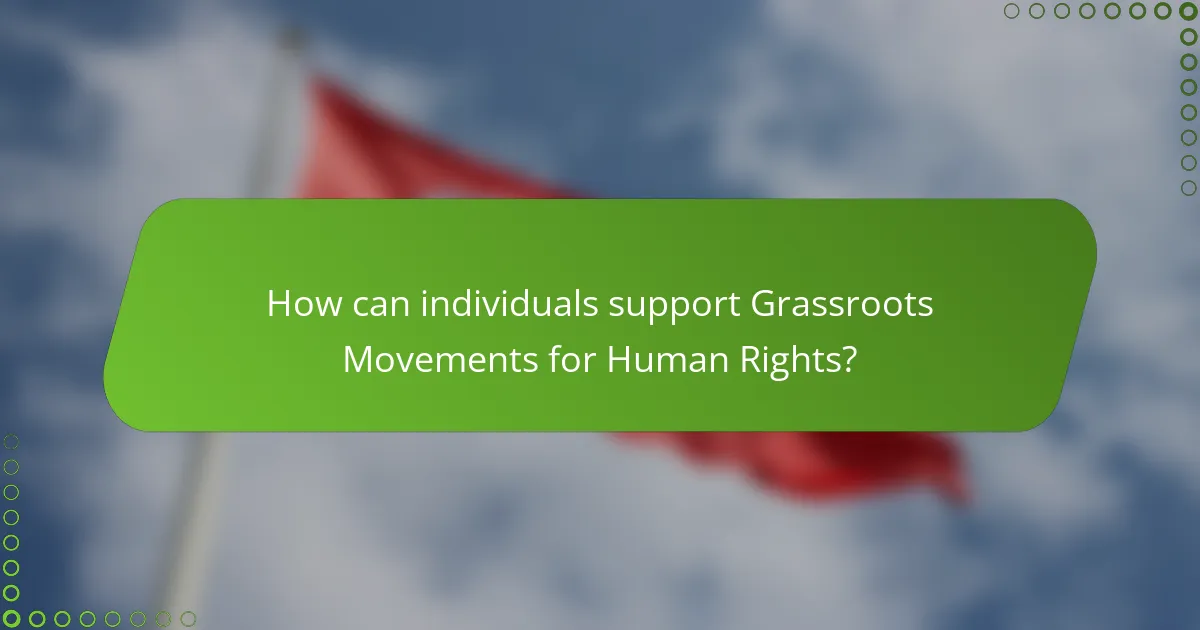
How can individuals support Grassroots Movements for Human Rights?
Individuals can support grassroots movements for human rights by volunteering their time and skills. Many organizations welcome assistance in organizing events, outreach, and advocacy efforts. Donations also play a crucial role; financial contributions help sustain operations and campaigns. Raising awareness through social media amplifies the movement’s message. Sharing information about human rights issues can mobilize others to take action. Attending events and participating in demonstrations show solidarity with the cause. Engaging in dialogue within communities fosters understanding and support for human rights. Collaborating with local groups can strengthen efforts and expand reach.
What actions can individuals take to get involved with Grassroots Movements?
Individuals can get involved with grassroots movements by volunteering their time. Many organizations rely on volunteers for events, outreach, and advocacy. Joining local groups allows individuals to connect with like-minded people. Participating in community meetings helps share ideas and strategies. Donating resources or funds supports the movement’s initiatives. Spreading awareness through social media amplifies the message to a broader audience. Signing petitions shows support for specific causes and can drive change. Attending rallies and protests demonstrates commitment and solidarity. Engaging in local politics can influence policies that align with grassroots goals.
How can volunteering enhance the impact of Grassroots Movements?
Volunteering enhances the impact of grassroots movements by increasing manpower and resources. It mobilizes community members who are passionate about social change. Engaged volunteers can amplify outreach efforts, spreading awareness of human rights issues. They contribute diverse skills that strengthen organizational capabilities. Research shows that grassroots movements with active volunteer participation achieve greater visibility and influence. For instance, the 2018 Women’s March in the U.S. drew millions, largely due to volunteer coordination. This collective action fosters community solidarity and encourages civic engagement. Ultimately, volunteers help build momentum for policy changes and social justice initiatives.
What are effective ways to raise awareness for Human Rights issues?
Effective ways to raise awareness for Human Rights issues include grassroots campaigns, social media engagement, and educational programs. Grassroots campaigns mobilize local communities to advocate for human rights. These initiatives often involve rallies, petitions, and community discussions. Social media platforms amplify messages and reach a broader audience. For example, hashtags like #HumanRightsMatter can trend and spark global conversations. Educational programs in schools and communities inform individuals about their rights. These programs can include workshops, seminars, and informational materials. According to a 2020 study by the Human Rights Campaign, community-based education significantly increases awareness and advocacy efforts.
What best practices should individuals follow when supporting Grassroots Movements?
Individuals should prioritize listening to grassroots leaders and communities. This ensures that support aligns with their needs and goals. Engaging in open dialogue fosters trust and collaboration. Providing financial support is crucial for sustainability. Donations should be directed to organizations with transparent practices. Volunteering time and skills can amplify efforts. Individuals can also leverage their networks to raise awareness. Sharing information through social media helps spread the movement’s message. Advocating for policy changes can further support grassroots initiatives. These practices enhance the effectiveness of grassroots movements in promoting human rights.
How can one ensure their support is effective and respectful of local communities?
To ensure support is effective and respectful of local communities, one must actively engage with community members. This involves listening to their needs and concerns. Conducting thorough research about the community’s history and culture is essential. Building trust through transparent communication fosters collaboration. Implementing initiatives that align with community priorities enhances effectiveness. Providing resources and training empowers local leaders. Monitoring and evaluating the impact of support ensures accountability. According to a study by the International Human Rights Funders Group, community-led initiatives are more successful when they prioritize local voices.
What resources are available for individuals wanting to learn more about Grassroots Movements?
Books on grassroots movements include “Grassroots Movements: How People are Changing the World” by Paul Wapner. Online courses are available through platforms like Coursera and edX, offering insights into activism and social change. Nonprofit organizations such as the Grassroots Institute provide workshops and resources. Websites like Idealist.org feature articles and job postings related to grassroots initiatives. Social media platforms often host discussions and live events focused on grassroots activism. Documentaries, such as “The Yes Men,” illustrate the impact of grassroots efforts. Academic journals like “Social Movement Studies” publish research on grassroots movements. These resources collectively enhance understanding of grassroots movements and their role in promoting human rights.
Grassroots movements are community-led initiatives focused on instigating social change and promoting human rights. This article explores their role in advocating for marginalized groups, highlighting historical examples such as the Civil Rights Movement and the anti-apartheid movement. It examines the differences between grassroots movements and traditional activism, key characteristics of grassroots initiatives, and the strategies they employ to mobilize community support. Additionally, the article addresses challenges faced by grassroots movements, the impact of political climates, and ways individuals can effectively support these efforts. Overall, it emphasizes the importance of grassroots activism in fostering community engagement and driving social change.
